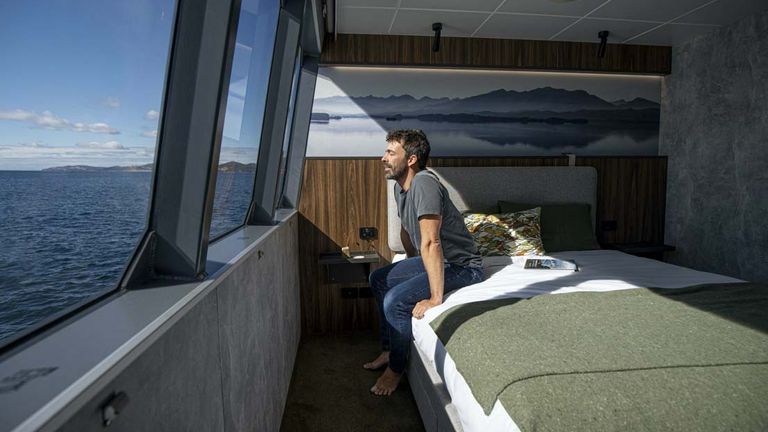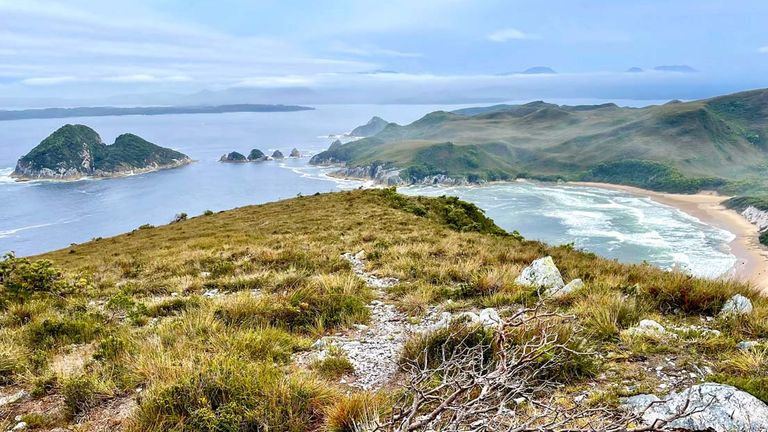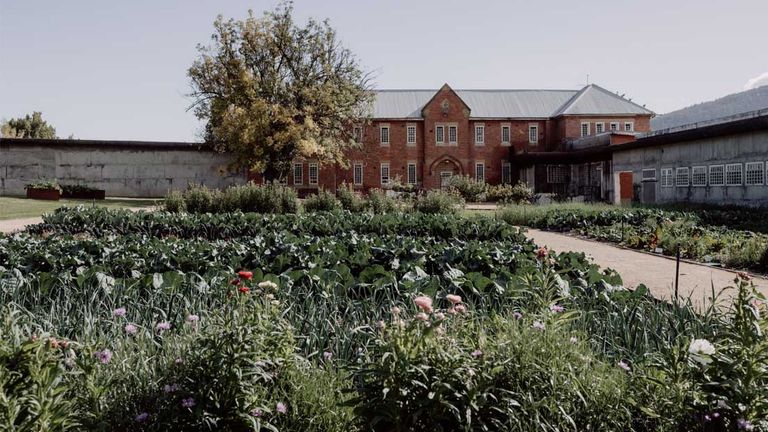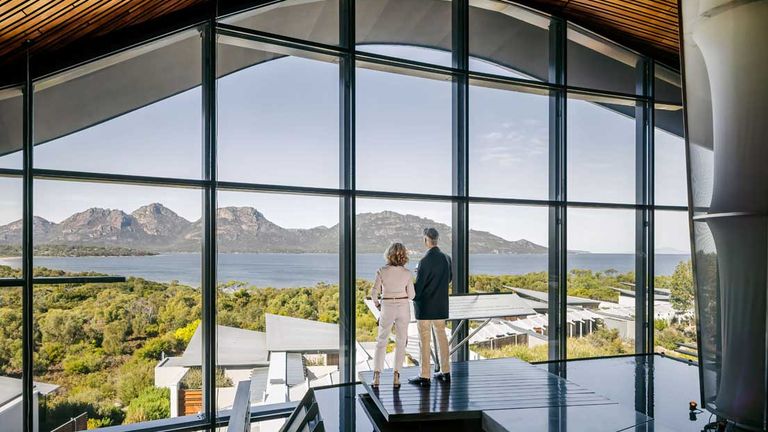Australia’s wild and quirky island state of Tasmania is an exciting destination for lovers of fresh-air adventures, remarkable animals, stunning scenery, gastronomic ingenuity and artistic audacity. Roughly comparable in size to Ireland, with just over half a million inhabitants, Tasmania is located about 155 miles off the southern coast of mainland Australia.
Hobart, Tasmania’s capital city, is easy to reach via a short, one-hour flight from Melbourne, and Air New Zealand also offers direct flights from Auckland. While it’s easy to enjoy Hobart’s vibrant history, extraordinary art scene and fabulous restaurants, there are plenty of temptations to lure visitors to regions beyond the city. Here are some destinations, tours, activities and culinary treats to try around the island.
Sea and Land
Since approximately 40% of Tasmania is protected wilderness, including 19 national parks, the state is a great place to go outside and play.
Guests of On Board, a new expedition cruise line (and award-winning member of Luxury Lodges of Australia), climb into a seaplane floating in Hobart’s harbor and soar over the mountains to reach the vast remote, and road-free Southwest National Park.
 On Board is an expedition cruise line and member of Luxury Lodges of Australia.
On Board is an expedition cruise line and member of Luxury Lodges of Australia.
Credit: 2025 On BoardAt the park, located in the UNESCO-listed Tasmanian Wilderness, they’re welcomed onboard 79-foot catamaran Odalisque III. Accommodating 12 passengers in seven cabins with all the comforts of a boutique hotel — including chef-prepared meals and locally sourced libations — the vessel embarks on four- and six-day itineraries with excursions to secluded inlets, pristine beaches and magnificent mountain terrain where clients can explore Tasmanian flora and fauna.
Travelers can also set off for an adventure with Tasmanian Walking Company, which offers a range of guided hikes, including the seven-day Cradle Mountain Signature Walk that traverses the renowned (and demanding) Overland Track. Additionally, Backroads is launching the new eight-day Australia’s Tasmania Multi-Adventure Tour that combines hiking, kayaking and cycling with cultural and culinary experiences.
 Southwest National Park is one of 19 in Tasmania.
Southwest National Park is one of 19 in Tasmania.
Credit: 2025 Laura BeausireNature and Wildlife
Located just a 30-minute drive from Hobart, Bonorong Wildlife Sanctuary is an inspiring refuge devoted to saving and rehabilitating Tasmanian wildlife. The sanctuary cares for rare and endangered species such as wombats, echidnas, eastern quolls, bettongs and Tasmanian devils, offering guided day and nighttime tours with opportunities for up-close animal interactions and the possibility of hand-feeding some of the creatures.
 The Tasmanian devil is only found on Tasmania.
The Tasmanian devil is only found on Tasmania.
Credit: 2025 Tasmania TourismFor another refreshing day trip from Hobart that’s especially appealing to foodies and nature enthusiasts, a short ferry ride to Bruny Island allows visitors to stroll gorgeous beaches, tour the historic Cape Bruny Lighthouse, sample local flavors — including cheese, oysters, beer, honey, whiskey and cider — scan the skies for Tasmania’s 12 endemic bird species and maybe even glimpse one of the island’s rare white wallabies.
Food, Wine and Spirits
Tasmania boasts four wine trails, and curious oenophiles will rejoice in sipping their way through cellar doors around the island. Launceston, about a two-hour drive north of Hobart, is a UNESCO City of Gastronomy, with a lively food and beverage scene located at the convergence of the North and South Esk rivers and the Tamar Estuary.
Nearby, House of Arras has garnered global accolades for its sparkling wine, and the winery offers on-site tasting adventures including the delightful Wine, Wildlife & Vineyard Walk. Visitors to the Josef Chromy estate can opt for the Let’s Do Lunch experience, which includes a tasting and a two-course meal accompanied by wine pairings at the winery’s celebrated restaurant. Another Launceston-area eatery deserving a detour is Timbre, where the seasonal menu showcases wood-fired delicacies made with locally grown ingredients.
Whiskey connoisseurs (and fans of adorable, historic towns filled with Georgian sandstone buildings) will want to head to Callington Mill Distillery in Oatlands (about halfway between Launceston and Hobart), to savor one of its Tasmanian single malts, take a tour or even craft a personalized bottle during the Serendipity Experience.
 The Agrarian Kitchen offers a restaurant and gardens on the site of a repurposed historic building.
The Agrarian Kitchen offers a restaurant and gardens on the site of a repurposed historic building.
Credit: 2025 The Agrarian KitchenCloser to Hobart, The Agrarian Kitchen in New Norfolk is a culinary paradise, offering an award-winning restaurant along with a tantalizing range of cooking and gardening classes, all nestled among the repurposed historic buildings of a former psychiatric hospital. Bangor Vineyard Shed, meanwhile, makes a dreamy day trip for a tour, tasting or leisurely gourmet lunch overlooking beautiful Boomer Bay.
History and Culture
For insights into Palawa (Tasmanian Aboriginal) culture, active travelers can join a four-day, small-group, east coast Wukalina Walk led by Aboriginal Tasmanian and Torres Strait Islander guides who share tales and traditions of their homeland. On this award-winning experience, guests have opportunities to help forage for bush tucker (food) and search for wallabies, wombats and whales on a beautiful coastal route to the Bay of Fires.
Tasmania’s convict history weaves throughout any visit to the island, and the Port Arthur Historic Site, a former penal settlement, is a powerful place of education and remembrance within an easy drive of Hobart.
In Launceston, Queen Victoria Museum and Art Gallery (known as QVMAG) and Design Tasmania are two family-friendly museums worth a stop for displays of local wonders ranging from extinct Tasmanian tigers to handcrafted wooden furniture.
Where to Stay
At Launceston’s Stillwater, clients enjoy exquisite accommodations in seven distinctive rooms, plus award-winning dining in a 180-year-old flour mill situated beside the splendidly scenic Cataract Gorge.
 Saffire Freycinet offers a luxury stay with great views of the Hazards mountain range.
Saffire Freycinet offers a luxury stay with great views of the Hazards mountain range.
Credit: 2025 Saffire FreycinetFor a stunning wilderness setting, it’s hard to beat the 19-room, adults-only Pumphouse Point, a repurposed 1940s hydropower building perched in the middle of Lake St. Clair — Australia’s deepest freshwater lake — and surrounded by national park land.
Meanwhile, the 20-suite, all-inclusive Saffire Freycinet, a member of Luxury Lodges of Australia, offers a sumptuous spa, a sophisticated restaurant and sweeping views of the Hazards mountain range and Great Oyster Bay within the east coast’s Freycinet National Park. The resort’s imaginative list of special offerings includes a Seafood and Sparkling Cruise and the Tasmanian Devil Experience.